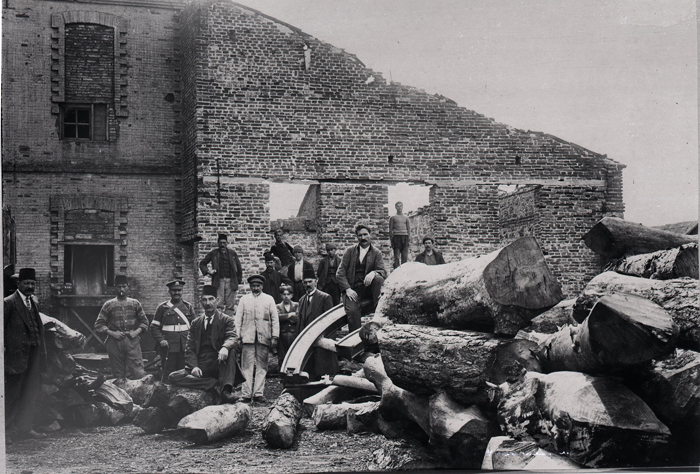Click here for all items related to: Anzac analysed
Why has Anzac become so important to Australians and what are the implications of this for our country in the 21st century? Contributions and references come from contemporary historians, journalists and others, and also from earlier sources of our history.

War Office photograph of gathering outside a ruined flour mill taken at Gallipolli [sic] during the unsuccessful Dardanelles Campaign, 1915 (source: Flickr Commons/National Archives of the United Kingdom, WO 317/1)
There are dozens of references under this heading and this summary only skims the surface, linking to only a proportion of the material. Users are urged to browse. Anzac analysis also cross-references frequently with items on the themes Using and abusing history, Australia’s war history and Ruling ourselves.
Australia’s great war historian, CEW Bean, was present at the creation of the Anzac tradition and followed it through to the foundation and development of the Australian War Memorial. Though we should be clear that the Gallipoli landing was not the beginning of Australia’s military history, as a new book edited by Stockings and Connor notes. Other writers note the strong residue of British influence (here and here) and the imperial defence planning background of the Gallipoli expedition (Lockhart, Meaney).
The history of the Anzac tradition has been chronicled most notably by Ken Inglis, for example, here and here. Anzac has not always been prominent in our history since 1915 but Australia’s distance from the battlefields of World War I has given a particular slant to our mourning of the dead from that conflict, as Bart Ziino has argued.
The resurgence of Anzac since 1990 has been reflected in the remarks of successive Prime Ministers (Hawke, Hawke, Keating, Keating, Howard, Howard, Rudd, Rudd, Gillard, Gillard and Abbott) and analysed by many commentators (for example, Beaumont, Carlton, McKenna, McKernan, Rundle, Stephens). The death of ‘the last Anzac’ in 2002 received particular attention from the then Prime Minister, although his eulogy was selective (Cahill). Keating twenty years on from his Unknown Australian soldier speech found World War I to be ‘devoid of any virtue’.
The Anzac tradition has been important in the military (Masters, Morrison, Twomey) and there has been a huge increase in the numbers of Australians visiting Gallipoli (Bowers, Fox, Hannaford and Newton, McKay, Scates).
Some writers have criticised the substitution of a mythologised view of Anzac for an evidence-based presentation of our history and have argued that the inflation of Anzac has overshadowed other important strands of that history (Daley and Wright, Lake et al, McKenna, Stephens, Whimpress). Cahill claims Anzac Day leaves out unsavoury aspects of our military history. World War I left Australia damaged in many ways (Beaumont, Lake, McMullin), the other side to the claim that our military exploits gave birth to the nation.
The critics have themselves been criticised by observers who welcome the continuing growth of the Anzac story (Bendle, Gower, Kelly). Meanwhile, commemoration of the Anzac centenary is well advanced, with the term ‘Anzackery‘ starting to be used. Misgivings about the way Anzac is being used come from young people (although by no means all of them), an academic, another academic, a former soldier, military historians, a theologian and a state governor.
Davison (here and here) suspects that the modern attitude to Anzac derives from divorcing ‘the past’ from history and that the eagerness of youth to travel to Gallipoli is a form of chauvinism. McGirr argues Anzac is used to make us feel larger. Finally, Gerster and, more recently, Broadbent, Campbell and Williams have noted the role of journalists in promoting a particular view of Australia’s military exploits.

